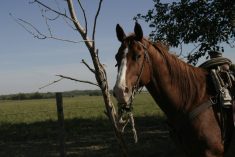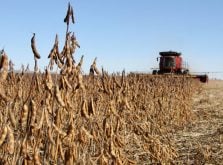Beef producers want an ear tag that can be scanned at a distance rather than the current wand reader that must be held close to a feisty steer’s head.
They may soon get their wish.
Researchers at SAIT Polytechnic in Calgary are working on ultra high frequency radio identification for livestock.
Low frequency tags must be read up close while UHF could be read 10 metres away.
“The higher the frequency, the faster you can do things. The lower you are in frequency, the longer it takes to read the tag,” said radio frequency identification specialist and SAIT instructor Glen Kathler.
Read Also

Horses challenged when asked to be weekend warriors
Horses are creatures of consistency. Their bodies and nervous systems are designed for steady, rhythmic movement, low-intensity grazing and regular social interaction.
“When you get into the business of commerce, we are not always in a state where we can read every tag one at a time.”
Alberta Agriculture is supporting the technical school’s efforts to build a better ear tag and study better readers.
“My mission is to experiment with the technology to the point of determining whether it is valid or not,” said Kathler.
“There have been a lot of studies in low frequency and how it works in this industry, but nobody really knows how this technology will work in a comparative playing field,” he said.
Students are also subjecting ear tags to the stress of Alberta weather and cattle handling systems. They already know it is difficult to transmit signals through water and metal, which are two common problems at feedlots and auction yards.
“We want to see about designing something that works in Alberta first and then it will probably work anywhere,” he said.
Kathler hopes to see a prototype ready for manufacture in May.
The low frequency button tag cannot get any smaller, but UHF tags are shrinking and the read range is improving.
Cattle tags now consist of a plastic button, an inlay of copper wire and the packaging. An inlay is an electronic chip the size of a grain of pepper surrounded by an antenna.
The passive tags contain a unique identification number that a reader awakens.
A UHF tag chip could store information such as the animal’s individual number, premise number, age and significant dates such as birth, movement off the farm and into a feedlot.
It can be locked with a password. Other livestock groups are also interested in the school’s research. A new equine project starts in September.
SAIT is also testing panel readers. Food traceability is the government’s main priority, but Kathler said there are further advantages: it eliminates paperwork, creates more accurate records and saves time and money.
Other industries already use UHF systems. Wal-Mart uses the technology to track inventory. Its system is capable of reading 600 tags per second as pallets move through the warehouse and retail system.
Rail companies in Europe mount a piece of plastic the size of a business envelope on rail cars. The tag carries the company’s unique identity chips that allows it to track location and predict delivery time whenever the cars pass a reader.















